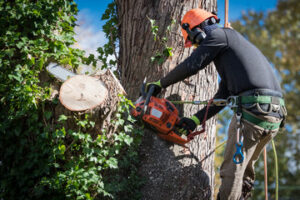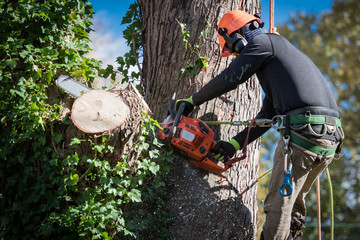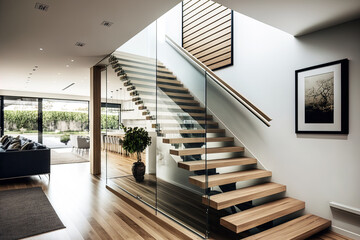Trees that are diseased, damaged, or dead may need to be removed. Other reasons include being in an undesirable location (such as being too close to a house) or shading out grass and other plants.

It is essential to recognize the signs of a problem. Then you can make the best decision about tree removal.
The cost of tree removal can vary widely, depending on several factors. Some of these factors include the size of the tree, location and accessibility, and whether it is near power lines or other obstacles. In addition to the cost of removing the tree, you may also need to pay for other services. For example, you may need to hire a crane or lift to remove the tree if it is too large for a climber. You may also need to pay for stump grinding and mulching, which can add up quickly.
Another factor that affects the cost of a tree removal is its condition. If a tree is dead or diseased, it will require special equipment and additional labor to be removed safely. In addition, a tree that is located close to buildings or power lines will also be more expensive to remove.
If you live in a rural area, the cost of tree removal will likely be less than if you lived in an urban area. This is because rural areas have more space to work, while urban areas often have cramped working spaces. In addition, you may be charged a travel fee for the arborist to drive to your property.
You may also have to pay for other services, such as stump grinding and mulching. These services can add up to a significant sum of money, especially when they are done by an experienced contractor. It is important to understand the cost of these services before you hire a tree removal company.
The price of gas can also impact the cost of tree removal. This is because arborists must pay for gas to fuel their machinery and transport it from one site to the next. This is especially true if the job is in a remote location or requires a long drive. In addition, some companies charge an extra fee for log splitting, which is usually an optional service for homeowners who have fireplaces. This can add up to $75 or more. Lastly, you may need to pay for insurance if your home is damaged by a falling tree.
Health
Trees provide shelter and food for many species of birds, animals, and insects. They also contribute to soil stability and aeration, and help maintain water quality. However, they can be a threat to buildings and power lines if they begin to deteriorate or fall over. It is therefore important to consider whether or not a tree can be saved before taking the drastic step of removing it.
Tree removal often involves a complex procedure that requires specialized equipment and techniques. This can make the process more expensive than pruning or simply letting it die. It is therefore important to consult with a tree expert before making the decision to remove a tree. They can assess the health of the tree and check for signs of pest infestation or structural problems that could threaten nearby structures. They can also recommend appropriate methods for re-establishing trees in the area, including the use of mulch to suppress weeds and conserve soil moisture.
It is not uncommon for people to request a tree be removed because of damage it has caused to their property. This damage may be due to its roots interfering with pipes, footings and foundations, or other underground utilities services. However, it is sometimes difficult to establish a direct cause-and-effect relationship between the root system and the damage, and many times the offending tree is guilty by association.
Nevertheless, it is still crucial to take steps to avoid the adverse effects of tree removal, including a lack of biodiversity in the surrounding ecosystem. The presence of a diversity of plant species promotes healthy soil and encourages the growth of beneficial microorganisms, which are essential for nutrient cycling, organic matter decomposition, and soil structure maintenance.
Another adverse effect of tree removal is a greater risk of erosion. Because tree roots penetrate deep into the ground, they can anchor the soil and prevent it from eroding. Without the stabilizing influence of the roots, the topsoil can easily wash away in rainstorms. This can have far-reaching environmental impacts, including clogging streams and rivers with sediment and disrupting aquatic ecosystems. To prevent this, a tree removal specialist may recommend implementing soil stabilization strategies such as planting grass or shrubs to anchor the soil and installing erosion control blankets and mats.
Safety
There are several safety hazards associated with tree removal, and it is best left to professionals. This is particularly true if the tree is diseased or dead, infested by pests, or close to buildings, structures or power lines. Performing tree removal in these situations can be hazardous and even deadly, especially for do-it-yourselfers. Safety equipment should be used, including goggles, gloves, hard hats and sturdy work boots.
Whether you’re doing the job yourself or hiring professionals, it’s important to pad the area around the site and remove any breakable items that may fall during the process. This will protect yourself, pedestrians and any workers involved in the project. It will also prevent any damage to your home or property, and can help the tree removal process move faster.
You should also check if the tree is damaged before starting. The best way to do this is by examining the trunk for long cracks, splits and cavities. Hollowness is another good indicator of a potential problem and should not be ignored. It’s important to remember that the more damage a tree has, the more likely it is to fall and cause harm.
Aside from safety concerns, there are also environmental issues to consider when deciding to remove a tree. For example, the process of removing a tree can result in soil compaction, which can have adverse effects on ecosystems. This is because the process can reduce pore space and soil density, thereby affecting water availability for plants and nutrient cycling.
Moreover, the removal of a tree can also alter the microclimate of a yard, which could lead to more severe weather events. This can impact the plant species that are suitable for a particular environment, as well as the amount of shade provided. Moreover, it can also change the way water moves across the surface of the earth. This can also affect the water supply, which can be a major issue in drought conditions. Additionally, the process of removing a tree requires a significant amount of energy and can lead to air pollution and carbon dioxide emissions.
Environment
Tree removal is an important part of urban land management, often necessary to address health or safety concerns. Specifically, trees that are infested with pests or near power lines may need to be removed to prevent injury to people or damage to property. Similarly, trees that are growing too close to buildings can pose a fire risk or be infected with diseases and need to be removed. However, the loss of trees can also have adverse environmental impacts.
One of the most significant is habitat loss, which can be caused by the removal of a single tree or multiple trees. Various wildlife species rely on the habitats provided by trees, including birds, squirrels, and insects. These animals rely on the trees for shelter and food sources. If the tree was their only source of food, for example, removing it can have devastating consequences. The loss of habitat can also lead to biodiversity loss.
Another environmental impact of tree removal is soil erosion. The roots of trees help stabilize the soil, preventing it from eroding. When trees are removed, the soil is more prone to erosion, which can cause property damage and reduce water quality.
Moreover, trees provide vital air quality benefits. They absorb carbon dioxide, reducing greenhouse gas emissions and improving air quality. They also produce oxygen, lowering the need for energy consumption and reducing pollution levels. However, many people are unaware of the environmental impacts of removing trees. They often mistakenly believe that if a tree is unhealthy or damaged, it must be removed.
Fortunately, there are several ways to mitigate the negative environmental effects of tree removal. These include mulching, which helps conserve soil moisture and suppresses weed growth. Mulching can also improve the quality of the soil by adding organic matter and nutrient content. Another option is to plant new trees in the area, choosing native species that are adapted to local conditions. This will help restore the biodiversity lost by the removal of existing trees. It is also important to consider the cultural and heritage values of a tree when making decisions about its removal. These values can affect the community’s reaction to a proposal for its removal, and may even influence the outcome of a request.

